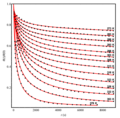Desorption
Desorption is a phenomenon whereby a substance is released from or through a surface. This is the opposite of absorption, wherein a substance diffuses into a material. The process is used in many scientific, environmental and industrial applications.
Process[edit]
Desorption may occur in two situations. If an atom or molecule is adhered to a solid surface, it may be removed by providing enough energy to overcome the chemical bond holding it there. Alternatively, if the substance is dissolved in a liquid or gas, it may be removed by altering the conditions to reduce the solubility so that the dissolved substance precipitates out.
Types of Desorption[edit]
There are several types of desorption processes, including:
- Thermal desorption - This is a remediation method used to clean contaminated soil or other material by heating it to a high temperature. The contaminants are vaporized and can then be collected and treated.
- Electron-stimulated desorption - This process involves the use of a beam of electrons to remove adsorbed atoms or molecules from a surface.
- Photon-stimulated desorption - This is a process where photons are used to remove adsorbed atoms or molecules from a surface.
- Desorption electrospray ionization - This is a method used in mass spectrometry to produce ions from a sample without the need for any preliminary treatment.
Applications[edit]
Desorption techniques are used in a variety of applications, including environmental remediation, food processing, and scientific research. For example, thermal desorption is often used to remove organic contaminants from soil, while desorption electrospray ionization is used in mass spectrometry to analyze the chemical composition of a sample.
See also[edit]
References[edit]
<references />
Ad. Transform your life with W8MD's Budget GLP-1 injections from $75


W8MD offers a medical weight loss program to lose weight in Philadelphia. Our physician-supervised medical weight loss provides:
- Weight loss injections in NYC (generic and brand names):
- Zepbound / Mounjaro, Wegovy / Ozempic, Saxenda
- Most insurances accepted or discounted self-pay rates. We will obtain insurance prior authorizations if needed.
- Generic GLP1 weight loss injections from $75 for the starting dose.
- Also offer prescription weight loss medications including Phentermine, Qsymia, Diethylpropion, Contrave etc.
NYC weight loss doctor appointmentsNYC weight loss doctor appointments
Start your NYC weight loss journey today at our NYC medical weight loss and Philadelphia medical weight loss clinics.
- Call 718-946-5500 to lose weight in NYC or for medical weight loss in Philadelphia 215-676-2334.
- Tags:NYC medical weight loss, Philadelphia lose weight Zepbound NYC, Budget GLP1 weight loss injections, Wegovy Philadelphia, Wegovy NYC, Philadelphia medical weight loss, Brookly weight loss and Wegovy NYC
|
WikiMD's Wellness Encyclopedia |
| Let Food Be Thy Medicine Medicine Thy Food - Hippocrates |
Medical Disclaimer: WikiMD is not a substitute for professional medical advice. The information on WikiMD is provided as an information resource only, may be incorrect, outdated or misleading, and is not to be used or relied on for any diagnostic or treatment purposes. Please consult your health care provider before making any healthcare decisions or for guidance about a specific medical condition. WikiMD expressly disclaims responsibility, and shall have no liability, for any damages, loss, injury, or liability whatsoever suffered as a result of your reliance on the information contained in this site. By visiting this site you agree to the foregoing terms and conditions, which may from time to time be changed or supplemented by WikiMD. If you do not agree to the foregoing terms and conditions, you should not enter or use this site. See full disclaimer.
Credits:Most images are courtesy of Wikimedia commons, and templates, categories Wikipedia, licensed under CC BY SA or similar.
Translate this page: - East Asian
中文,
日本,
한국어,
South Asian
हिन्दी,
தமிழ்,
తెలుగు,
Urdu,
ಕನ್ನಡ,
Southeast Asian
Indonesian,
Vietnamese,
Thai,
မြန်မာဘာသာ,
বাংলা
European
español,
Deutsch,
français,
Greek,
português do Brasil,
polski,
română,
русский,
Nederlands,
norsk,
svenska,
suomi,
Italian
Middle Eastern & African
عربى,
Turkish,
Persian,
Hebrew,
Afrikaans,
isiZulu,
Kiswahili,
Other
Bulgarian,
Hungarian,
Czech,
Swedish,
മലയാളം,
मराठी,
ਪੰਜਾਬੀ,
ગુજરાતી,
Portuguese,
Ukrainian





